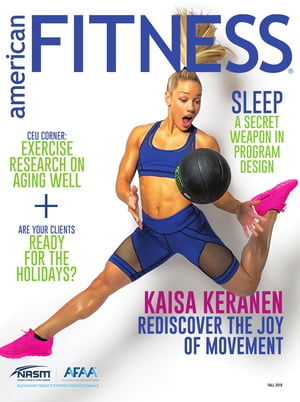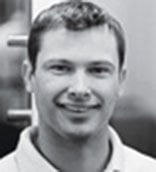 Originally appeared in the fall 2018 issue of American Fitness Magazine.
Originally appeared in the fall 2018 issue of American Fitness Magazine.
All the corrective exercise in the world may not resolve a postural problem that is continually perpetuated. Therefore, counteracting tech neck is about not only correcting posture but also avoiding the positioning that ultimately led to the compensations in the first place.
Chances are, whether you are trying to win a foot race, peering longingly into the eyes of a loved one or even reading this article, you are doing it. Most of us are doing it every day for hours on end as we look at our computers, tablets and phones. I’m talking about defaulting to a forward-head position, or tech neck.
As fitness professionals, it is vital for us to address the goals our clients have, as well as to increase their awareness of postural compensations they may not yet know about.
It is particularly important that we pay attention to the head position while clients exercise, as a forward-head position during resistance training can exacerbate problems associated with tech neck.
What Is Tech Neck?
Tech neck is when the head juts forward and often downward as we look at tech devices sitting on our desks, propped in our laps or held in our hands. Because there is often a correlation between forward-head positioning and other postural woes - such as kyphosis (increased flexion in the thoracic spine) and a protracted shoulder girdle - this can lead to a rounded back and internal rotation at the shoulder joint.
The tech-neck position is not rooted in tight neck muscles. Rather, it is the position of the devices we are using that causes us to round our upper back, protract our heads forward and often tilt them downward, as well.
However, when we spend prolonged periods in this position, adaptive shortening does occur, causing muscles responsible for the forward-head position to repeat and encode a motor pattern and become mechanically short.
As the lack of structural integrity spreads from a primary site to a secondary one, identifying the root cause of pain or discomfort becomes more difficult. All of the postural dysfunctions need to be addressed, but identifying and starting at the primary site of dysfunction (in this case, the tech neck) is more highly indicated.
Muscles associated with "tech neck"
A few of the major muscles involved are mentioned below, along with their roles in tech neck. Synergistically, these muscles protract the head forward and tilt it upward into extension. Though this is not an exhaustive list of the muscles contributing to tech neck, they are primary players.
UPPER TRAPEZIUS AND ELEVATED SHOULDERS. The upper trapezius runs from the top of the shoulder blades up the back of the cervical spine, ending at the base of the skull. This muscle can concentrically create extension in the cervical spine and extension of the head on the cervical spine. The upper trapezius can also elevate the shoulder girdle, leading not only to the forward-head position but also to shrugged (or hunched) shoulders.
LEVATOR SCAPULAE AND SHOULDER TENSION. The upper trapezius gets blamed for a lot of issues that the levator scapulae is responsible for creating, such as scapular elevation, cervical extension and the shoulder stiffness that can accompany tech neck. The upper trapezius and levator scapulae have several joint actions in common, including cervical extension and elevation of the scapula, and the two muscles work synergistically in the tech-neck position.
STERNOCLEIDOMASTOID (SCM) AND FORWARD POSITIONING OF THE HEAD. The SCM runs from the sternum (S) and the clavicle (C) to the mastoid process (M), which is the bony landmark behind the base of the ear. Keeping in mind that the anchoring point is on the front of the body and the attachment point on the back of the head, it is easy to visualize how this muscle pulls the head forward—becoming easily overworked when this position is assumed for long periods of time, day after day—and tilts the head into extension.
UPPER-BACK EXTENSORS AND FORWARD-ROUNDED SHOULDERS/BACK. Thoracic flexion, or rounding of the upper back, can either lead to a forward head or develop from it. Upper-back rounding indicates weakness in the thoracic extensor muscles. Trainers often focus more on retraction and depression of the shoulder blades (i.e., pulling the shoulders “back and down”) to address thoracic kyphosis, but strengthening the extensors of the upper back is more highly indicated.
DEEP CERVICAL FLEXORS AND A DOWNWARD-TILTING HEAD. Other muscles that must be addressed are the weak and underactive muscles that allow tight muscles (and gravity) to pull the head out of ideal postural alignment into a downward tilt. This happens particularly in people who gaze down at a phone or laptop rather than leaning forward toward a computer screen. These “weak and underactive” muscles include deep cervical flexors like the longus capitus and longus coli, which are designed to retract and flex the cervical spine.
Problems and Pain From Tech Neck
Aside from unflattering posture, what’s wrong with having a forward head? Poor biomechanics combined with repeated motion (dynamic posture) or repeated lack of motion (static posture) can lead to pain and pathology at the cervical spine. Below is a small list of issues that commonly result from tech neck.
NEURAL IMPINGEMENT AND PAIN. When the head juts forward and extends, the space between vertebrae becomes narrower. This space, where the nerve roots leave the spinal cord, is known as the foramen. As the foramen narrows, it can impinge upon (or pinch) the nerve root. This can lead to sharp pain near the point of impingement and/or shooting pain down the path of the nerve. There may also be unexplained tingling along the line of the nerve that is being impinged. If you suspect a client has neural impingement, send the client promptly to a doctor.
DISK HERNIATION AND/OR PAIN. There are many degrees of disk herniation, but a simple explanation of this condition is that the disks between the thick bony segments in the vertebral column begin to bulge or balloon in areas. This does not always lead to pain. In fact, many people have disk herniations without any associated pain. However, when a disk balloons out so far that it pushes against the root of a nerve, there can be moderate to severe pain.
HEADACHES. There are several different types of headaches, but here we are specifically referring to tension headaches. These occur when muscles around the neck and head become tight. Pain often presents as a squeezing sensation (like a band) around the head.
FACET JOINT ARTHRITIS, BONE DEGENERATION AND BONE SPURS. Facet joints occur where a flat bone articulates with another flat bone (as in much of the spinal column), and they slide along the surface of each other. The additional burden of a forward head can facilitate deterioration of cartilage between these bones, potentially causing arthritis. This cartilage deterioration can also lead to eburnation, defined as degeneration of bone into an ivory-like mass as a result of prolonged rubbing. Eburnation can lead to the development of osteophytes, more commonly known as bone spurs, in the cervical spine.
Talking to Clients About Movement Patterns
As a fitness professional, you know that the nervous system encodes patterns that cause us to follow predictable movements based on how often a pattern is practiced. Here’s one way to use imagery to help clients understand the need to constantly monitor and counteract a poor movement pattern or posture: The encoding of motor patterns in the nervous system is like the carving of a riverbed where water has run for a long time. The longer and deeper the riverbed, the more difficult it is to redirect the water.
This is where the NASM Corrective Exercise Continuum is particularly smart. It not only pays attention to releasing and stretching tight muscles and facilitating activation in underactive muscles; it also includes the neuromuscular re-education that is needed afterward to encode new patterns. However, if we take clients through a series of steps to fix a problem and then the clients go right back to looking down at devices in their laps or lunging toward a desktop screen, they will not enjoy a long-lasting solution.

Perhaps clients can use tech to become more aware of tech neck—for example, by setting reminders on a smartphone to do a “neck check” or to stand up and stretch every 30 minutes or so.
Preventing the Return of Tech Neck
Ultimately, for both our clients and ourselves, we need to set up an environment that allows us to keep our heads up. This can look odd. A trainer at one of my gyms in New York City was holding his phone up to his face rather than dropping his face toward his phone. It looked as if he was taking photos or videos of the gym and those in it. I actually had to request that he take his perfect phone posture to a more isolated location so as not to make patrons and clients uncomfortable. I guess no good posture goes unpunished!
There are many articles and insights on the ergonomics of screens, and it seems that all screens need to be brought in line with the head. Knowing this will not necessarily keep people from jutting their head forward—clients can’t think about head position the entire time they are at a computer. However, if we help them become aware of the malalignment and learn how to keep posture top of mind, they can begin to encode a better neural pathway.
Raising Awareness to Realign Posture
Clients need to be conscious of their postural propensities; they need to think about their posture, fix it when out of alignment, and be aware of their tendency to let the head drift anteriorly when they are looking at a tech device. Perhaps they can use tech to become more aware of tech—for example, by setting reminders on a smartphone to do a “neck check” or to stand up and stretch every 30 minutes or so. They can also simply reposition their devices closer to the head, rather than moving the head closer to the devices.
As children who never knew life without a smartphone, tablet or computer grow into adulthood, fitness professionals are likely to see tech neck rear its ugly head more and more frequently. By explaining and applying the approaches detailed in this article, we can hack tech neck and help ourselves and our clients avoid the flesh-and-bone ramifications of this modern-day dilemma.
Earn More by Offering More With the NASM-CES

If you want to make more money while helping your clients move, feel and live better, consider corrective exercise. The NASM Corrective Exercise Specialization (NASM-CES) teaches static and dynamic assessments that will help you identify imbalances and design effective programs using the Corrective Exercise Continuum.

















